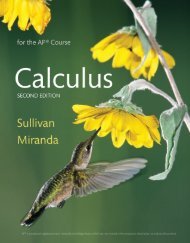SPA 3e_ Teachers Edition _ Ch 6
Create successful ePaper yourself
Turn your PDF publications into a flip-book with our unique Google optimized e-Paper software.
418<br />
C H A P T E R 6 • Sampling Distributions<br />
Teaching Tip<br />
The rule of thumb mentioned here is<br />
sometimes called the 10% condition. As<br />
long as the sample size is less than 10%<br />
of the population size, the sample count<br />
will have a distribution that is close<br />
enough to a binomial distribution that<br />
binomial probabilities will be reasonably<br />
accurate.<br />
Teaching Tip<br />
Remind students that the mean is also<br />
called the expected value!<br />
In practice, we can ignore the violation of the independence condition caused by<br />
sampling without replacement whenever the sample size is relatively small compared<br />
to the population size. Specifically, we can assume that the sampling distribution of a<br />
sample count X is approximately binomial when the sample size is less than 10% of<br />
the population size.<br />
Center and Variability<br />
Because the sampling distribution of a sample count X is approximately binomial<br />
when the sample is a small fraction of the population, we can use the formulas from<br />
Lesson 5.4 to calculate the mean and standard deviation of X.<br />
How to Calculate μ x and σ x for a Binomial Distribution<br />
Suppose X is the number of successes in a random sample of size n from a large population<br />
with proportion of successes p. Then:<br />
• The mean of the sampling distribution of X is m X = np.<br />
• The standard deviation of the sampling distribution of X is s X = "np(1 − p).<br />
The formula for the mean is always correct, even if we are sampling without<br />
replacement. However, the formula for the standard deviation is not appropriate to<br />
use when the sample size is more than 10% of the population size.<br />
Alternate Example<br />
Rubber ducky, are you the one?<br />
Mean and SD of the sampling<br />
distribution of X<br />
PROBLEM: A popular carnival game<br />
has players choose a rubber duck from<br />
a small pool and look under the duck.<br />
If a special mark is on the duck, the<br />
player wins a prize. Suppose that a pool<br />
has 5000 ducks, 800 of which have the<br />
special mark. One generous father pays<br />
for his children to choose 20 rubber<br />
ducks. Let X 5 the number of ducks with<br />
the mark in the sample of 20.<br />
(a) Calculate the mean and standard<br />
deviation of the sampling distribution of X.<br />
(b) Interpret the standard deviation<br />
from part (a).<br />
a<br />
e XAMPLe<br />
How many flash drives are defective?<br />
Mean and SD of the sampling distribution of X<br />
PROBLEM: Two percent of the flash drives in a shipment of 10,000 flash drives are defective. An<br />
inspector randomly selects 10 flash drives from the shipment and records X 5 the number of<br />
defective flash drives in the sample.<br />
(a) Calculate the mean and standard deviation of the sampling distribution of X.<br />
(b) Interpret the standard deviation from part (a).<br />
SOLUTION:<br />
(a) m x = 10(0.02) = 0.2 flash drives<br />
s x = "10(0.02)(1 − 0.02) = 0.44 f lash drives<br />
(b) If the inspector took many samples of size 10, the number of<br />
defective flash drives would typically vary by about 0.44 from<br />
the mean of 0.2.<br />
Because the sample size is less than 10% of the<br />
population size, the distribution of X is approximately<br />
binomial with n 5 10 and p 5 0.2. The mean is m X = np<br />
and the standard deviation is s X = "np(1 − p).<br />
FOR PRACTICE TRY EXERCISE 1.<br />
SOLUTION:<br />
(a) m X = 20a 800 b = 20(0.16) = 3.2<br />
5000<br />
ducks with the mark<br />
s X = "20(0.16)(1 − 0.16) = 1.64 ducks<br />
with the mark<br />
(b) If the children took many samples<br />
of 20 ducks, the number of ducks with<br />
the mark would typically vary by about<br />
1.64 from the mean of 3.2.<br />
Starnes_<strong>3e</strong>_CH06_398-449_Final.indd 418<br />
Teaching Tip<br />
The interpretation of the mean and standard<br />
deviation in the preceding example is the<br />
same as in past chapters. Connect the ideas of<br />
past lessons to the current one!<br />
18/08/16 5:00 PMStarnes_<strong>3e</strong>_CH0<br />
418<br />
C H A P T E R 6 • Sampling Distributions<br />
Starnes_<strong>3e</strong>_ATE_CH06_398-449_v3.indd 418<br />
11/01/17 3:55 PM




